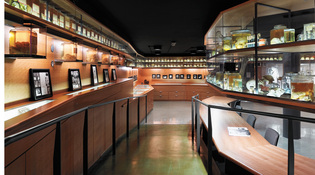 loading
loading
The brain cutter Christopher GardnerThe Cushing Center, designed by Turner Brooks ’65, ’70MArch, with Aaron Amosson ’03MArch, is a custom-made miniature museum with study space and a seminar room. View full imageThe other key to his success, along with the caution and audacity, was meticulous record keeping. It started when he was assisting with surgery as a student, using a sponge to administer ether, and the patient died in front of the entire class. Appalled and mortified, Cushing and a classmate soon developed “ether charts,” to keep track of a patient’s heart and respiration rates—his “first major contribution to medicine,” according to a recent profile in the Journal of Neurosurgery: “Such charting revolutionized surgery by greatly curbing complications and deaths” from anesthesia. A few years later the young surgeon became infuriated over a second mishap, a pathology department’s loss of a golf ball–size piece of brain tissue before he had had a chance to examine it. He demanded the right to retain all his own specimens, leading to the creation of the Cushing Brain Tumor Registry, a carefully maintained collection of tissues, detailed medical records, sketches, and patient photographs. His insistence, over the rest of his career, on almost compulsively recording what he saw enabled him to sort through irrelevant or inconsistent details and zero in relentlessly on essential facts. It also inadvertently documented the birth of neurosurgery. In the course of inventing neurosurgery, Cushing also created the cult of the brain surgeon as high priest, difficult, demanding, devoted to his work above all else. “Not many men down here liked him,” a Baltimore colleague wrote. “He rode roughshod over them and was ruthless. Yet he had his moments and could be as charming and delightful as anyone else. Only there weren’t many such moments. … Tough hombre. Yeah, but one of America’s immortals.” If Cushing could be brutal to hospital staff, he was also extraordinarily self-sacrificing on behalf of patients. “A nurse never forgot the time a child who had been tracheotomized for diphtheria had his tube accidentally withdrawn and rushed into the hallway choking,” Bliss writes. “Cushing took hold of the boy, put his mouth to the wound, sucked out the mucus, blood, and disease-membrane, then reinserted the tube.” Staffers who could live up to “the chief’s” high standard earned his loyalty. Louise Eisenhardt, who started as a secretary in 1915, went on to become a physician herself, a rare accomplishment for a woman then, and possible only with Cushing’s support. Trusted staffers tended to be intensely loyal in turn. When someone once proposed bypassing one of Cushing’s fussy rules, a lab worker replied, “Orders is orders, and if Dr. Cushing says that the building should be burned down,” it would soon lie in ashes. Cushing’s wife Kate and their five children paid the price for his devotion. Once, after he had made a visit home between bouts of travel and work, she wrote, “I couldn’t talk to you Harvey—you weren’t interested.” And when he contemplated moving to Boston while she remained in Baltimore, she replied that they “would simply drift further and further apart—you absorbed in your work. I—in my work and possibly somebody else who happened to be interested in me a little.” His reply surely did not soothe her: “An awful day—hot and muggy—a bad ganglion case—several foreign visitors on my chest—patients throwing fits at unfortunate moments … and not the least your depressing letter.” As “the chief” approached retirement age, Harvard treated him with an attitude his protégé and later biographer John Fulton characterized as “patronizing stupidity.” Among Europeans, Fulton wrote, Cushing “is regarded as the outstanding figure in American medicine of this or any previous epoch. In Harvard he is merely a troublesome member of the medical faculty.” Cushing left Harvard unceremoniously in 1932 and moved to Yale, bringing with him his priceless collection of more than 7,000 antiquarian medical books, and later the entire Tumor Registry. The books became the basis of the medical school’s historical library. A new generation of neurosurgery students also continued to use the Tumor Registry as an educational tool for years after Cushing’s death in 1939 (a heart attack at age 70, after lifting a weighty volume of a sixteenth-century illustrated human anatomy). But Cushing’s methods inevitably began to seem antiquated, and the Tumor Registry, with all its strange neurological incunabula, got put away and forgotten.
|
|